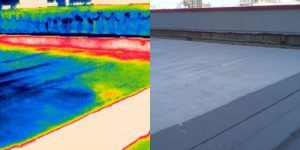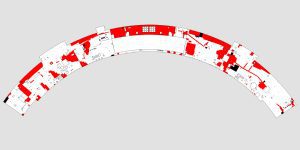While we can’t claim to have X-ray vision like Superman, we do have tools in our Non-Destructive Testing and Evaluation (NDT&E) arsenal that give us the equivalent of superpowers. Infrared Thermography (IR) and Electrical Impedance (EI) scanning are powerful technologies that supplement visual observation.

IR allows our team to “see” in the infrared spectrum—handy for spotting a variety of roof and facade conditions, from air leaks at joints and seals to thermal bridging across weeps to missing insulation and entrapped moisture.
EI meters reach 2-4 inches below the surface, measuring the subtle phase shift between voltage and current waveforms to detect subsurface moisture—essentially, whether areas are wet or dry. This technology offers another non-destructive probe option for conditions where IR isn’t feasible.

For building exteriors, IR alone is best for heat-loss surveys, usually conducted in the winter (or occasionally summer) months. For roof moisture surveys, IR can be thwarted by ballasted roofs, shade from adjacent structures or rooftop mechanicals, and certain reflective membranes. For that matter, IR roof moisture surveys must be conducted at the right time of day, in the right season, and under the right weather conditions to be effective.
EI scanning won’t work for all kinds of roofs and conditions, either. It’s hampered by perimeter flashing and drain pans, by EPDM (carbon black) roofs, and reflective aluminized roofs. But for roofs free of these factors, it’s often the best choice for creating a comprehensive map of moisture and insulation conditions.
The key to using these technologies to their best advantage given the types of building materials and environmental conditions at hand is knowing which tool to use—or which tools in combination. We always prefer EI surveys over IR surveys for roof moisture testing and recommend using the two methods in tandem for other applications such as interior surveys.
As the old saying goes, “if the only tool you have is a hammer, you tend to see every problem as a nail.”1 Unlike specialized IR firms, SUPERSTRUCTURES employs IR, EI, and many other technologies to analyze and diagnose building envelopes. But our most important asset is know-how: the experience to choose the best tool for the job and know how to use it.
14 Wall Street, 25th Floor, New York, NY 10005
(212) 505 1133
info@superstructures.com
Subscribe to SuperScript, our email newsletter.